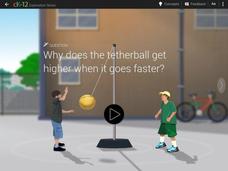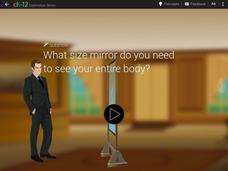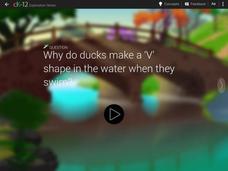CK-12 Foundation
Driverless Car
Who's driving that car? Science is! Through a simulation, learners adjust the magnitude and angle of motion on a driverless car. Two different motions create a resultant motion. Vectors represent the motion and graphs depict the...
CK-12 Foundation
Violin
Learners explore the science of sound by considering the characteristics that make unique sounds. Through an interactive simulation, they adjust tension and string size and view the corresponding wavelength and amplitude changes.
CK-12 Foundation
Bobsled
Bobsled riders' safety depends on skill ... and physics! Learners use a simulation to understand the physics behind the sport. They manipulate the speed, mass, and/or turn radius of the sled and watch the effects on the centripetal force.
CK-12 Foundation
Cliff Diver
Cliff diving is more than an adrenaline rush ... it's a lesson in physics! Scholars adjust the height of a cliff and plot the resulting velocity and position over time on graphs. They also can incorporate air resistance to monitor the...
CK-12 Foundation
Tetherball
What forces are at work when playing tetherball? Using a simulator, pupils control the ball mass, tether length, and ball speed to better understand the physics of the game. A worksheet and challenge questions reinforce the concepts...
CK-12 Foundation
Butterfly Stroke
Swimmers improve their times by understanding the physics of their sport. As a swimmer moves through the water, the efficiency of motion affects the resulting velocity. Through an interactive simulation, pupils change the level of motion...
CK-12 Foundation
Wind Turbine
Scientists know wind is a renewable resource, but is it an efficient one? Scholars adjust the propeller diameter on a wind turbine, the wind speed, and the conversion efficiency within range to learn about the efficiency of these...
CK-12 Foundation
Roller Coaster
Roller coasters rely on both kinetic and potential energy, but how much total energy does a roller coaster need? Scholars vary the mass of a coaster and the height of the initial hill. Graphs showing the types of energy and total energy...
CK-12 Foundation
Magnifying Glass
How can a magnifying glass or reading glasses make things appear larger? Scholars simulate moving a lens closer or farther from an object to observe the resulting image. They also alter the lens focal length. The simulation shows the...
CK-12 Foundation
Least Time
What is the fastest way to get from point A to point B if you are going through two different mediums, such as air then water? Scholars explore the way light travels through air, water, acrylic, glass, and diamond as they answer this...
CK-12 Foundation
Touch Screen
Touch screens are becoming more common, but how do they work? The simulation shows the electric potential versus system charge as scholars alter three variables. The schematic of the capacitance demonstrates the set up as each variable...
CK-12 Foundation
Pan Flute
How can a pan flute sound one note while we hear a chord? The simulation explores sound waves, vibrations, and harmonics at the molecular level. Scholars control the pipe into which air is being blown, the length of the pipe, and which...
CK-12 Foundation
Position and Displacement Simulation
How can we use vectors to determine a person's position when traveling? The simulation offers guided practice at determining the coordinates and the distance between coordinates on a map grid. It reinforces the importance of positive...
CK-12 Foundation
Archery
Archery is believed to be one of the oldest sports in the world at more than 25,000 years old—meaning it can teach your classes a lot! Scholars learn about the forces interacting in the archery simulation. They control the archer's...
CK-12 Foundation
Unicycle
What is the steepness of a hill before a unicyclist slides down it rather than pedaling down it? The simulation graphs the wheel speed versus the unicycle speed as the rider goes down a hill. Scholars control the mass of the rider,...
CK-12 Foundation
Prom Night
Create the perfect prom night image using the Law of Reflection! An interactive lesson explores angles of reflection when looking in a full-length mirror. Learners change the distance from the mirror and length of the mirror and watch...
CK-12 Foundation
Doppler Ducks
The study of waves is not a quacking matter! Watch as a duck manipulates the behavior of its waves through its motion. Graphs show the frequency and wavelength of the waves.
CK-12 Foundation
Bow and Arrow
Where does the energy of an arrow come from? Is it from the person, the bow, or somewhere else? A simulation allows scholars to adjust the stretch distance and the elastic constant in order to understand where the energy comes from, what...
CK-12 Foundation
Hot Air Balloon
How can people control a hot air balloon? The simple simulation allows scholars to adjust the payload mass, burner, and vent position on a hot air balloon and observe the changes in velocity and altitude over time. Challenge questions...
CK-12 Foundation
Airplane
How does an airplane control its take off and descent? Scholars explore the forces acting on an airplane and control the angle of attack, wing profile, thrust, and airplane size. They learn about lift, drag, thrust, gravity, and the...
CK-12 Foundation
Malt Shop
How does the soda clerk know exactly how to get the glass across the counter to the customer? Pupils use the simulation to adjust the launch velocity, glass weight, base area, surface material, and the customer's position to answer that...
CK-12 Foundation
Walk the Tightrope
Why do many tightrope walkers use a balancing pole? The simulation explores the benefits of balancing poles and the features that are most important. Pupils control the pole length, pole mass, pole stiffness, and the initial angle of...
CK-12 Foundation
Loop-the-Loop
What prevents a roller coaster from falling when it goes upside down? Scholars experiment with a roller coaster simulation controlling the mass of the coaster, the height of the hill, and the radius of the loop. They learn which factors...
CK-12 Foundation
Ballistics Tests
How did scientists measure the speed of incredibly fast things before the invention of high-speed photography? Scholars virtually perform ballistics tests to discover the process. They control the rifle type, bullet mass, and target...

























